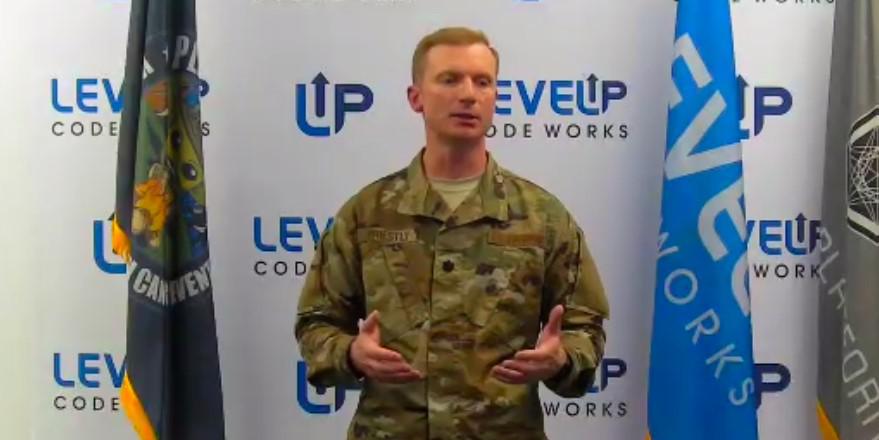Putting Cyber Software First
Less than a year old, the San Antonio-based LevelUp Code Works Software Factory is succeeding in starting to “break the mold” of Defense Department software development. The factory, which had its grand opening last December, is providing key cyber-related products to U.S. military cyber organizations, says Lt. Col. John Priestly, program manager and materiel leader, Unified Platform Program; and director, LevelUp Code Works Software Factory.
LevelUp officials work closely with the U.S. Cyber Command and the service cyber components in creating digital cyber solutions, as well as providing software tools to the services and the Unified Combatant Commands, the colonel explained to virtual luncheon attendees at an August 18 AFCEA Alamo event.
“U.S. Cyber Command and the service cyber components participate throughout each of our program increments, all the way in the beginning, to planning out which capabilities to how we're going to prioritize, what is going to go into the backlog, and then moving forward into actual development and execution,” Col. Priestly said. “They are shoulder-to-shoulder with us all the way through to the demonstration and delivery of capability. And that's been a huge win for us.”
The factory centers on employing the latest development security operations, or DevSecOps, for creating, securing, deploying and operating cyber-related software. For that, LevelUp harnesses commercial technology and automation, the director noted. “We're going down the path of DevSecOps approaches, which requires us to automate to the maximum extent our ability to test, investigate security, provide cybersecurity and the effectiveness of these applications, micro services and software packages that we're delivering,” the director said.
LevelUp also has turned to an agile acquisition model that is built around three-month incremental planning that supports the continuous delivery of solutions to the military through release of minimum viable products, the colonel said. Having acquisition professionals stationed at the facility also serves the model well. It supports the preparation of all levels of software, from new applications to pulling in existing commercial or governmental off-the-shelf technology to adapt to the military’s needs, he shared.
The software factory’s off-base location in downtown San Antonio was important in setting the culture, Col. Priestly continued. The workspace is a relaxed environment in which airmen are not required to wear uniforms, donning civilian clothes instead. On a day-to-day basis, the factory can host 160 employees, although naturally, during the pandemic working in person has been a bit curtailed.
“We are definitely not a typical government outfit in a building on a base,” he said. “We are located in the budding tech district. That situates us in an area where we can take advantage of what San Antonio has to offer as well as reach out beyond the local area.”
In addition, the factory supports the software creation for the military’s Unified Platform as well as Platform One. The Uniform Platform, a U.S. Cyber Command component, is a robust set of cyber tools for analyzing data and information from defensive and offensive cyber operations. The Unified Platform also integrates various cyber capabilities and infrastructure for the Command’s Cyber Mission Force, which conducts broad scale cyber activities.
“Unified Platform is that interconnectivity between disparate systems as well as the data layer for the warfighting architecture,” he explained.
Platform One, meanwhile, has grown to be one of the DOD’s major enterprise software platforms, Col. Priestly said. “While both the Unified Platform and Platform One share a common vision and teammates, in many ways, Platform One has now become the DOD enterprise service for DevSecOps. It's really blossomed over the past year, and it provides a DevSecOps platform in some cases as a service for many important DOD programs.”
And while the colonel could not go into detail about the capabilities that the factory has already delivered—given the sensitive nature of their cyber work—LevelUp has successfully provided six program increments and is right in the middle of the seventh. “Each of our six program increments have contributed to the success of our cyber operational forces,” he noted.
The director looks to the software practices of leading companies, such as Amazon, Google, Netflix and Uber, whose software engineers quickly develop and deliver code—every 11.7 seconds on average for Amazon and thousands of times per day for Netflix. “This is at the heart of their commercial advantage and their success,” Col. Priestly said. “That is a really big game changer for them, and it allows them to be flexible and adapt and be sure that they are providing the capabilities that their users need. It has a lot to do with how we have modeled our organization.”
Until recently, DOD’s competitive disadvantage was that software development time was measured in years, the colonel stressed. “In a lot of ways, we have the unenviable track record of not implementing the transformational change that is necessary,” he said. “But I’m encouraged that changes are taking place, both in our culture, our policies and our willingness to lean forward and take risks in the right areas. The DOD and the Air Force are making real progress and LevelUp is right in the middle of that transformational change.”





Comments